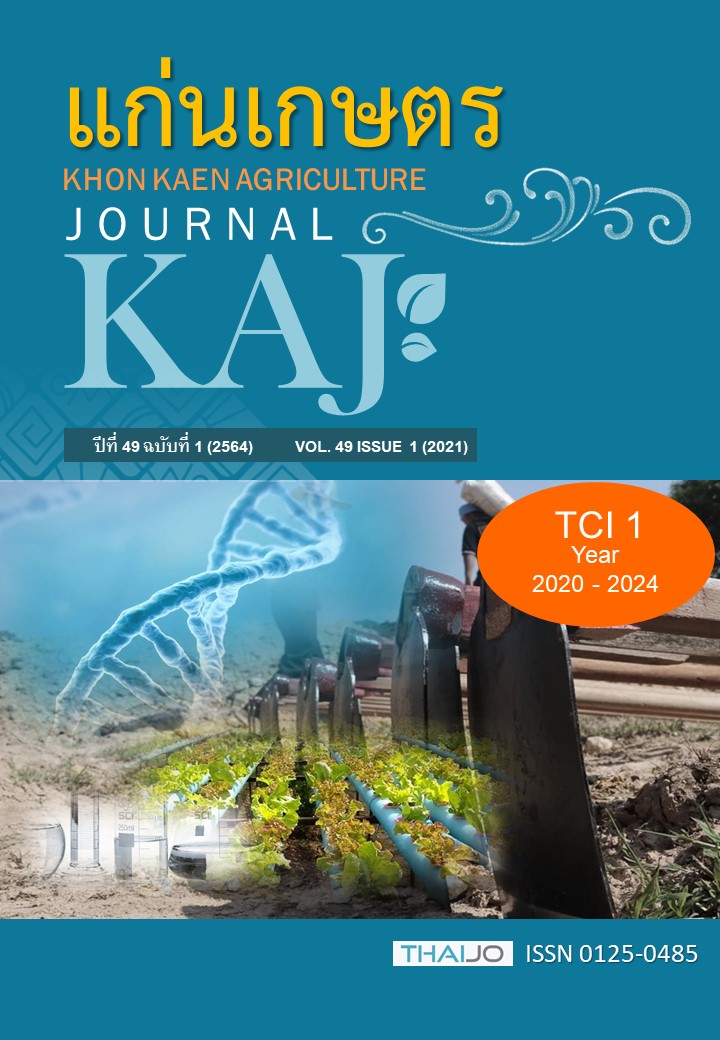ผลของเหล็กและแมงกานีสต่อข้าวขาวดอกมะลิ 105 ที่ปลูกในดินนาต่างชนิด
Main Article Content
บทคัดย่อ
ทำการปลูกข้าวขาวดอกมะลิ 105 ในโรงเรือนเพื่อศึกษาการตอบสนองต่อเหล็กหรือแมงกานีสในอัตราที่แตกต่างกัน ได้แก่ 0, 2, 4, 8 และ 16 มก. เหล็ก/กก. หรือ 0, 0.5, 1.0, 2.0 และ 4.0 มก.แมงกานีส/กก. ในดินนาชุดดินท่าตูม ชุดดินร้อยเอ็ด และชุดดินอุบล พบว่า ความสูงของข้าวที่ปลูกในดินทั้งสามลดลงตามอัตราเหล็กที่เพิ่มขึ้นอย่างมีนัยสำคัญทางสถิติ ขณะที่จำนวนรวงของข้าวในชุดดินร้อยเอ็ดเพิ่มขึ้นอย่างมีนัยสำคัญทางสถิติตามอัตราของเหล็ก (11.0-11.3 รวง/กระถาง) ยกเว้นในอัตรา 4 มก./กก. แต่การใส่เหล็กในอัตรานี้กลับให้น้ำหนักเมล็ดข้าวในดินอุบลสูงที่สุดอย่างมีนัยสำคัญทางสถิติเท่ากับ 17.2 ก./กระถาง ส่วนการใส่เหล็กในอัตราอื่น ๆ ให้น้ำหนักเมล็ดไม่แตกต่างจากตำรับควบคุม (6.93-8.37 ก./กระถาง) ยกเว้นในอัตรา 8 มก./กก. ที่ให้ค่าต่ำที่สุด (5.17 ก./กระถาง) แมงกานีสไม่มีผลต่อองค์ประกอบผลผลิตของข้าวแต่ให้ความสูงของข้าวในชุดดินท่าตูมและชุดดินร้อยเอ็ดไม่แตกต่างจากตำรับควบคุม (155-156 ซม.) ยกเว้นในอัตรา 2 มก./กก. ที่ให้ค่าสูงสุดเท่ากับ 162 และ 165 ซม.ตามลำดับ เหล็กและแมงกานีสเพิ่มโภชนาการของข้าวทางสถิติโดยการใส่เหล็กทำให้เหล็กและสังกะสีในเมล็ดข้าวกล้องสูงสุดเมื่อใส่ในอัตรา 2 มก./กก. ขณะที่แมงกานีสเพิ่มเพียงความเข้มข้นของสังกะสีในเมล็ดข้าวกล้องในชุดดินร้อยเอ็ดเมื่อใช้ในอัตรา 4 มก./กก. การใส่แมงกานีสในอัตรา 0.5 และ 1 มก./กก. ทำให้ข้าวสะสมและดูดใช้ธาตุอาหารหลักเพิ่มขึ้นทางสถิติ ส่วนเหล็กทำให้ข้าวในดินท่าตูมและอุบลดูดใช้ฟอสฟอรัสและโพแทสเซียมลดลงขณะที่อัตราที่ทำให้ข้าวสะสมและดูดใช้ไนโตรเจนเพิ่มขึ้นแปรปรวนในแต่ละดินอยู่ในพิสัย 4-16 มก./กก. ความเข้มข้นของเหล็กในเนื้อเยื่อพืชไม่มีสหสัมพันธ์กับผลผลิตข้าว แต่ความสูงของข้าวมีสหสัมพันธ์กับแมงกานีสในตอซังข้าว (r = 0.73*) และในเมล็ด (r = 0.88*) เช่นเดียวกับจำนวนรวงข้าวที่มีสหสัมพันธ์กับแมงกานีสในตอซังข้าว (r = 0.73*)
Article Details

อนุญาตภายใต้เงื่อนไข Creative Commons Attribution-NonCommercial-NoDerivatives 4.0 International License.
เอกสารอ้างอิง
ตลาดสินค้าเกษตรล่วงหน้าแห่งประเทศไทย. 2554. ข้าวหอมมะลิมิติใหม่สู่การลงทุนในตลาดสินค้าเกษตรล่วงหน้า. http://www.afet.or.th/v081/thai/learning/publication.php.
แสงนวล ทองเพียร และ อัมรา เวียงวีระ. 2548. ลักษณะพิเศษของข้าวหอมมะลิ. น.ส.พ. กสิกร. 78: 6-11.
Abid, M., N. Ahmad, M. Jahangir, and I. Ahmad. 2002. Effect of zinc, iron and manganese on growth and yield of rice (Oryza sativa L.). Pakistan Journal of Agricultural Sciences. 39: 177-180.
Dobermann, A., and T. Fairhurst. 2000. Rice: Nutrient Disorders and Nutrient Management. Potash and Phosphate Institute. Canada.
Duraisamy, V.P., and A.K. Mani. 2001. Effects of zinc and iron on yield, content, uptake and soil fertility under samai in a red loamy sandy soil. Mysore Journal of Agricultural Sciences. 35: 297-301.
Fageria, N.K. 2014. Mineral Nutrition of Rice. CRC Press.
Fan, X., M.D. Rezaul Karim, C. Xinping, Z. Yueqiang, G. Xiaopeng, and Z. Fusuo. 2012. Growth and iron uptake of lowland and aerobic rice genotypes under flooded and aerobic cultivation. Communications in Soil Science and Plant Analysis. 43: 1811-1822.
Fang, Y., L. Wang, Z. Xin, L. Zhao, X. An, and Q. Hu. 2008. Effect of foliar application of zinc, selenium, and iron fertilizers on nutrients concentration and yield of rice grain in China. Journal of Agricultural and Food Chemistry. 56: 2079-2084.
FAO/WHO. 2000. Preliminary report on recommended nutrient intakes. Report of a Joint FAO/WHO Expert Consultation on Human Vitamin and Mineral Requirements. Sep 21-30, 1980, Bangkok, Thailand.
Gomaa, M.A., F.I. Radwan, E.E. Kandil, and M.A.M. Shawer. 2015. Impact of micronutrients and bio-fertilization on yield and quality of rice (Oryza sativa, L.). Middle East Journal of Agriculture Research. 4: 919-924.
Kabata-Pendias, A., and H. Pendias. 2001. Trace Elements in Soils and Plants, 3th edition. CRC Press LLC.
Kulandaivel, S., M.B. Gangaiah and P.K. Mishra. 2004. Effect of levels of zinc and iron and their chelation on yield and soil micronutrient status in hybrid rice (Oryza sativa L.)-wheat (Triticum aestivum L.) cropping system. Indian Journal of Agronomy. 49: 80-83.
Kumar, V., D. Kumar, Y.V. Singh, R. Raj, and N. Singh. 2018. Effect of iron nutrition on plant growth and yield of aerobic rice. International Journal of Chemical Studies. 6: 999-1004.
Lindsay, W.L., and W.A. Norvell. 1978. Development of a DTPA soil test for zinc, iron, manganese, and copper. Soil Science Society of America Journal. 42: 421-428.
Mousavi, S.R., M. Shahsavari, and M. Rezaei. 2011. A general overview on manganese (Mn) importance for crops production. Australian Journal of Basic and Applied Sciences. 5: 1799-1803.
Rakesh, D., P. Raghuramireddy, and P.M.D. Latheef. 2012. Response of aerobic rice to varying fertility levels in relation to iron application. Journal of Research Angrau. 40: 94-97.
Rout, G.R., and S. Sahoo. 2015. Role of iron in plant growth and metabolism. Reviews in Agricultural Science. 3: 1-24.
Sanchez, P.A. 2019. Properties and Management of Soils in the Tropics. Cambridge University Press.
Xiaoyun, F., Md. K. Rezaul, C. Xinping, Z. Yueqiang, G. Xiaopeng, Z. Fusuo, and Z. Chunqin. 2012. Growth and iron uptake of lowland and aerobic rice genotypes under flooded and aerobic cultivation. Communications in Soil Science and Plant Analysis. 43:1811-182


